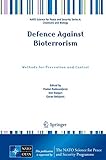Defence Against Bioterrorism : Methods for Prevention and Control / edited by Vladan Radosavljevic, Ines Banjari, Goran Belojevic.
Material type: TextSeries: NATO Science for Peace and Security Series A: Chemistry and BiologyPublication details: Dordrecht, The Netherlands: Springer, c 2018Edition: 1st ed. 2018Description: viii, 272 pages : illustrations (some color) ; 24 cmISBN:
TextSeries: NATO Science for Peace and Security Series A: Chemistry and BiologyPublication details: Dordrecht, The Netherlands: Springer, c 2018Edition: 1st ed. 2018Description: viii, 272 pages : illustrations (some color) ; 24 cmISBN: - 9789402412635
- 363.3253 23 RAD-D 2017 72194
| Item type | Current library | Collection | Call number | Copy number | Status | Date due | Barcode | Item holds | |
|---|---|---|---|---|---|---|---|---|---|
 Books
Books
|
School of Intergrated Social Sciences Library Book Cart | Book | 363.3253 RAD-D 2017 72194 (Browse shelf(Opens below)) | C 1 | Available | 72194 |
Preface (Vladan Radosavljevic) -- Chapter 1: Introduction (Vladan Radosavljevic) -- Chapter 2: Synthetic Biology, Dual Use Research, and Possibilities for Control (Eckard Wimmer) -- Chapter 3: The Global Threats from Naturally Occurring Infectious Diseases (Alessandro Mancon) -- Chapter 4: Refugee crisis as a potential threat to public health (Raynichka Mihaylova-Garnizova) -- Chapter 5: A Perspective on the Strategy of Intelligence (Randall Murch) -- Chapter 6: Comparison of the Available Methods of Differentiation Between a Biological Attack and Other Epidemics (Goran Belojevic) -- Chapter 7: Primordial and Primary Levels of Biothreat and Bioterrorism Prevention (Vladan Radosavljevic) -- Chapter 8: Secondary Level of Biothreat and Bioterrorism Prevention (Vladan Radosavljevic) -- Chapter 9: Preventative Medicine: research and use of medical countermeasures during an outbreak (Inger Damon) -- Chapter 10: Rapid and Low-Cost Tools Derived from Plants to Face Emerging/ Re-Emerging Infectious Diseases and Bioterrorism Agents (Rosella Franconi) -- Chapter 11: Panic disorder during a bioterroristic attack (Milan Latas) -- Chapter 12: Safety and Security Regulations against Biological Threats (Anna Bielecka-Oder) -- Chapter 13: The Role of Bioforensics in Medical Bio-Reconnaissance (Lothar Zöller) -- Chapter 14: The role of informal digital surveillance systems before, during and after infectious disease outbreaks: A critical analysis (Avi Magid) -- Chapter 15: Strategic aspects of countering bioterrorism (Katarina Strbac) -- Chapter 16: Food and Bioterrorism - The Case of Airline Catering (Ines Banjari) -- Chapter 17: Food safety, Standards and Norms against Bioterrorism (Adela Krivohlavek) -- Chapter 18: Environment and bio-terrorism (Wattier-Grillot Stephanie) -- Chapter 19: Ethical aspects of bioterrorism and biodefence (Elizabeta Ristanovic) -- Chapter 20: Concluding remarks (Vladan Radosavljevic).
This volume is based on a multidisciplinary approach towards biological and chemical threats that can, and have been previously used in bioterrorism attacks around the globe. Current knowledge and evidence-based principles from the fields of synthetic biology, microbiology, plant biology, chemistry, food science, forensics, tactics, infective medicine, psychology and others are compiled to address numerous aspects and the complexity of bioterrorism attacks. The main focus is on biological threats, especially in the context of synthetic biology and its emerging findings that can be observed as possible threat and tool. The book examines microorganisms and their possible use in forensics, id est as possible detection tool that could enable fast and precise detection of possible treats. A number of plant derived components are also discussed as possible agents in bioterrorism attacks, and in relation to infectious disease pathology. Another integral part is food safety, especially in terms of large food supply chains, like airline caterings, institutionalized kitchens et cetera Food can be observed as a possible mean of delivery of various agents (biological and chemical) for bioterrorism attacks. Steps on how to recognize specific critical points in a food supply chain, along with proposed corrective activities are discussed. Examples from around the globe, along with the methodological approach on how to differentiate bioterrorism attacks from other epidemics are provided. However, epidemics are also discussed in the context of migrations, with the special emphasis on the current refugee migrations that affect not only Europe, but also the United States. The book will be of interest to experts from various fields of science as well as professionals working in the field. The book encompasses examples and tools developed for easier, more specific, and faster detection of possible bioterrorism treats, along with proposed actions for some aspects of a bioterrorism attack..
